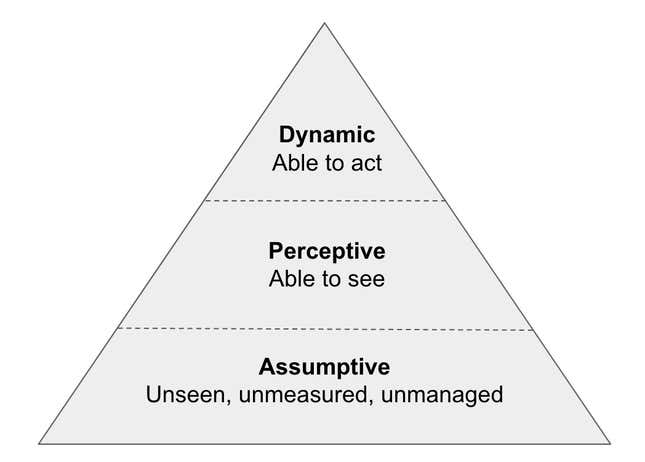Matt McLarty is the global field CTO for MuleSoft at Salesforce, where he works closely with organizations to define digital strategies and design and implement enterprise-grade digital solutions.
I get to help organizations digitally transform, which gives me the privilege of working with leaders at some of the world’s largest and fastest-moving organizations. Yet I’m always struck by how hard it is for these companies—whether it’s in the C-suite, the technology team, or the engine room—to get a sense of what’s going on at any given time. How healthy is the business? How aligned are current operations with strategic intent? How is morale at all levels?
Given the complexity of people, processes, and technology at most enterprises, organizational awareness needs to be a core competency to which leaders must pay attention. While business leaders navigate the current stormy macroeconomic waters, this awareness will be their compass. The companies will be the ones who not only survive, but also thrive in this climate.
As employees look internally within their companies to determine how they contribute to overall organizational awareness, they must start by determining how awareness is tracked and measured. Then, it’s important to decide how it is being executed and what tools and practices are in place to maintain an organization’s awareness baseline.
3 questions to analyze organizational awareness at your company
The easy part of addressing organizational awareness is recognizing the need. The hard part is getting started. Here are three questions to help develop organizational awareness and increase your career success:
1. Does the organization have a clear mission?
Each organization is responsible for communicating its vision, mission, values, cultural behaviors, and goals. While company visions may be aspirational, the mission is something that every individual at a company is working towards and should be the driving force behind each task, no matter how big or small.
Mission-based organizations also promote agility. The plans and goals needed to achieve and contribute to the mission may change as the business needs change, but ultimately the mission will remain the same. At Salesforce, we use the V2MOM process to create alignment between the company missions and daily tasks. V2MOM stands for vision, values, methods, obstacles, and measures. Each team and individual at Salesforce has a V2MOM that ladders up to the corporate one, and the process of defining and refining the V2MOM allows everyone in the organization to see how their work contributes to the company’s vision. Let the vision act as a north star, and employees within an organization will always remain confident about what mission they are trying to achieve.
2. Are there proper communication paths organization-wide?
The responsibility to communicate within an organization is two-fold. First, regardless of a person’s hierarchical position within a company, they are responsible for communicating directly with anyone in the organization they need to work with. If those individuals hit a wall because of rules that are put in place above them, then they’re no longer responsible for not achieving their desired outcome.
For example, consider a big company with lots of interconnected technology systems. If an application developer from one area uses services from another area, how can they go about getting features added, fixing bugs, or even having questions answered on those services? Organizations that lack awareness might force that developer to go to someone superior in their reporting chain who can connect to a peer from the other area. They would then need to delve into their own organization to find the right person to address their need. Gene Kim, author of The Unicorn Project, calls this approach “The Square.” It is highly inefficient and leads to slow, questionable results. It is much more effective to have clarity around organizational responsibilities and permission to engage directly with colleagues across organizational boundaries.
It is also the responsibility of leadership, or those higher within an organization, to facilitate proper and healthy communication paths. This way, leadership can focus on tracking toward the mission, values, and goals while simultaneously empowering middle managers and individual contributors to stay on top of the day-to-day business and operations.
3. Can digital tools and techniques provide real-time visibility and management?
Given the degree to which most organizations run on software and data, leaders should consider how they can leverage digital tools and techniques to increase their organizational awareness. I believe there are three levels of maturity around digital organizational awareness. First, assumptive organizations at the bottom level lack the tooling to derive insights from the technology that runs their day-to-day business. Instead, these organizations may rely on hunches and anecdotal signals through human communication paths, creating significant margins for errors in understanding and hindering their agility.

McLarty’s Hierarchy of Organizational Awareness Needs
Most organizations are one layer up as perceptive organizations. They understand business operations through pre-built dashboards and data visualizations, giving them a good read on their business in near real-time. However, many of these organizations are unable to utilize those insights and act on key data efficiently. Manual effort and organizational coordination are required without the dashboard and visualizations, often leading to delays, errors, and missed opportunities.
Dynamic organizations in the top layer are able to measure their business, analyze the data, and act on it in digitally-enhanced ways, including process automation and personalized user experiences. This is the approach taken by the leaders of the digital economy, and this level of digital organizational awareness drives timely innovation, first-mover advantage, and better business outcomes. Organizations must take a composable approach to business to get to this level. These dynamic organizations package their business capabilities in a digestible way that both provides measurements and visibility and also allows for the rapid introduction of new processes, experiences, and products. Strategic investment in technologies and techniques that promote this approach to business will help create more efficient business operations and drive higher organizational awareness.
